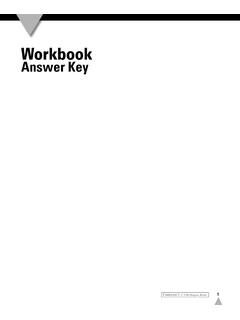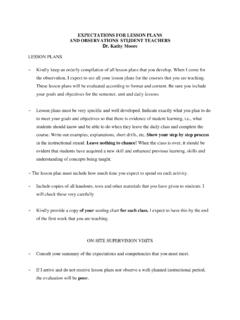Transcription of Pearson Environmental Science Workbook Answer Keys
1 Appendix C Textbook: Environmental Science Answer Key for guided reading Workbook : Chapter 1 Section 1 Living Things and the Environment guided reading and Study 1. Use Target reading Skills One way students might map the information is: Main Idea: An organism obtains food, water, shelter, and other things it needs from its environment. Detail: Each organism must live in a specific type of environment, called its habitat. Detail: Organisms live in different habitats because they have different requirements for survival. Detail: One area may contain many habitats. include food, water, and shelter. , b, d factors factors , sunlight, oxygen, temperature, soil , c 10.
2 Photosynthesis 11. b, d 12. A species is a group of organisms that are physically similar and can mate with each other to produce offspring that can also mate and reproduce. , b, c ecosystem also includes abiotic factors. Chapter 1 Section 2 Studying Populations guided reading and Study Use Target reading Skills Possible student questions and answers are these: How do you determine population size? (Some methods of determining population size are direct observation, indirect observation, sampling, and mark-and-recapture studies.) What causes populations to change in size? (Some factors include birth, death, immigration, and emigration.) What are limiting factors?
3 (These are factors that can limit population growth if they are unfavorable for the organisms in the population. Food and water, space, and weather conditions can be limiting factors.) 1. b 2. a 3. d 4. c 5. Populations can change in size when new members enter the population or when members leave the population. 6. The major way new individuals are added is through the birth of offspring. rate major way individuals leave is by dying. rate 10. false 11. b 12. a 13. true 14. limiting factor 15. Some limiting factors are food and water, space, and weather conditions. 16. carrying capacity 17. true 18. Frost can kill organisms, and floods and hurricanes can wash away nests and burrows.
4 Chapter 1 Section 3 Interactions Among Living Things guided reading and Study Use Target reading Skills Possible answers: What You Know 1. Organisms interact in different ways. What You Learned 1. Organisms are adapted to their environments. 2. Organisms have niches, which are their roles. 3. Organisms compete for resources. Some organisms eat others, and this affects the size of populations. 4. Some organisms live together in symbiotic relationships, of which there is mutualism (both benefit), commensalism (one benefits, the other is not helped or harmed), and parasitism (one benefits, the other is harmed). 1. c 2. a 3. b 4. false 5. true 6. predation, predator, prey 7.
5 True 8. Column 1: Commensalism, Parasitism; Column 2: Both species benefit. 9. parasite, host Chapter 1 Section 4 Changes in Communities guided reading and Study Use Target reading Skills Possible answers: Primary Succession volcanic eruption, no soil or organisms exist, no Secondary Succession fire, soil and organisms exist but have been disturbed, yes 1. Succession is the series of predictable changes that occur in a community over time. 2. Primary succession is the series of changes that occur in an area where no soil or organisms exist. 3. a, b 4. pioneer species 5. lichens, mosses 6. As they grow on bare rocks with little or no soil, they help break up the rocks.
6 When they die, they provide nutrients that enrich the thin layer of soil that is forming on the rocks. 7. secondary succession 8. Natural disturbances include fires, hurricanes, and tornadoes. 9. Human activities include farming, logging, and mining. 10. false 11. climate Chapter 2 Section 1 Energy Flow in Ecosystems guided reading and Study Use Target reading Skills Possible sentences: In a food chain, a consumer could be an herbivore, an omnivore, or a carnivore, including a scavenger. An energy pyramid shows how much energy moves from one level to another in a food web, beginning with the producers. Decomposers are nature s recyclers. 1. c 2. b 3. a 4.
7 Producers include plants, algae, and some bacteria. 5. false 6. true 7. bacteria, fungi 8. Column 1: Herbivore, Omnivore, Scavenger; Column 2: Only animals 9. true 10. food chain 11. Grass is Producer. Mouse is First-level consumer. Kestrel is Second-level consumer. 12. food web 13. c, d 14. It shows the amount of energy that moves from one feeding level to another in a food web. 15. a, d 16. There are usually few organisms at the top because there is a limited amount of energy available at that level of a food web. Chapter 2 Section 2 Cycles of Matter guided reading and Study Use Target reading Skills 1. Water evaporates. 2. Clouds form. 3. Precipitation falls.
8 4. Precipitation runs off or becomes groundwater. , molecules , b cycle results in the formation of clouds. 10. rain, snow, sleet, hail 11. false 12. c, d 13. fixation Chapter 2 Section 3 Biogeography guided reading and Study Use Target reading Skills Three causes of dispersal: Wind, water, and living things, including humans 1. biogeography 2. It is the very slow movement of the continents on a layer of solid rock called plates. 3. true 4. false 5. dispersal 6. Wind, Water, Living things 7. Wind disperses the seeds of plants, the spores of fungi, tiny spiders, and many other small, light organisms. 8. A bird may eat seeds and deposit them in its waste in another location.
9 A duck may carry algae or fish eggs on its feet from pond to pond. A dog may carry sticky plant seeds on its fur. 9. false 10. exotic species 11. physical barriers, competition, climate 12. Examples include water, mountains, and deserts. 13. If species already in the area are thriving, they may outcompete a new species and act as a barrier to its dispersal. 14. climate 15. true Chapter 2 Section 4 Biomes guided reading and Study Use Target reading Skills Temperate rain forest: cool winters, warm summers; rather wet all year; mule deer. Tropical rain forest: warm all year; wet all year; orangutan. Desert: usually hot with great daily extremes; dry all year; Gambel s quail.
10 Grassland: temperatures vary throughout year; mostly dry with a wet season; grasses. Deciduous forest: warm in summer, cold in winter; moderate rainfall; red fox. Boreal forest: warm to cool in summer, cold in winter; abundant rain and snow; lynx. Tundra: cold all year; dry all year; mosses. 1. biome 2. true 3. b 4. canopy 5. Temperate rain forests are farther from the equator and cooler than tropical rain forests. 6. Some are located along the northwestern coast of the United States. , d , d 10. deciduous trees 11. a 12. Coniferous trees are found in a boreal forest. 13. a, b, d 14. tundra 15. a, b, c 16. true 17. Organisms adapted to life on the ice include penguins, polar bears, and seals.







